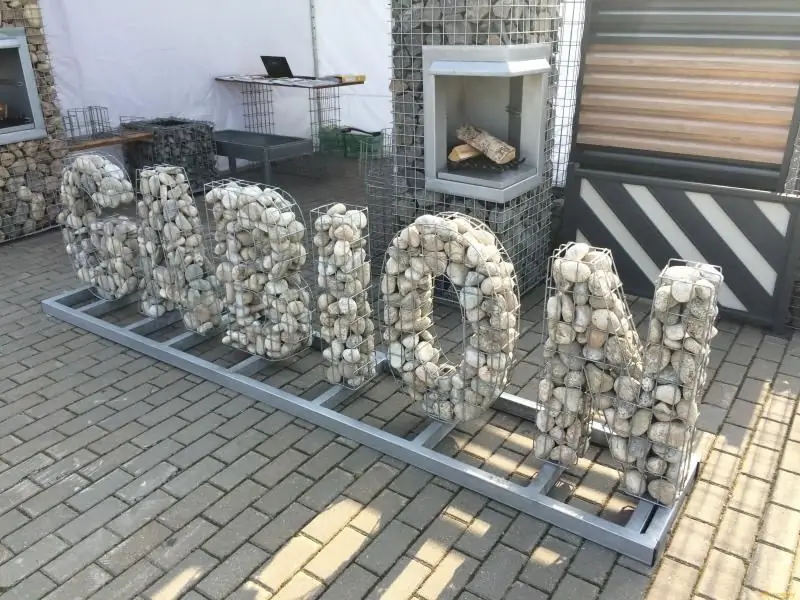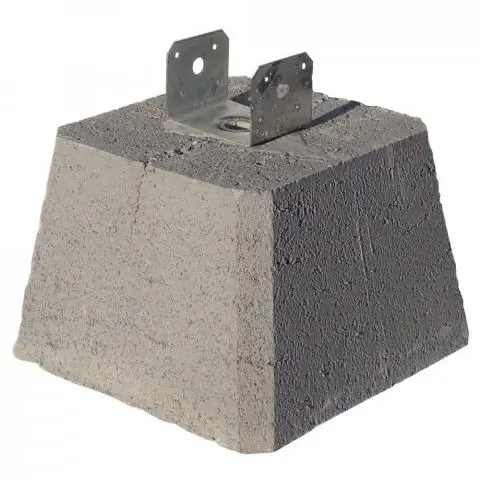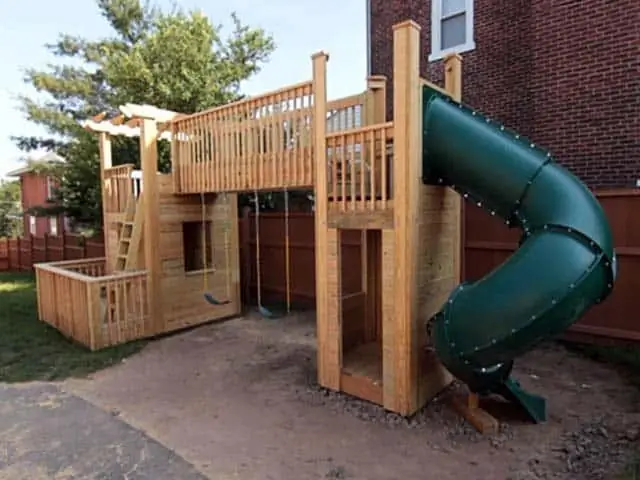
Table of contents:
- Author Bailey Albertson [email protected].
- Public 2024-01-17 22:26.
- Last modified 2025-01-23 12:41.
Gabions in your garden: how to make a practical DIY decoration

Each of us wants to see our garden beautiful, well-groomed and modern. Landscaping specialists regularly suggest new ways to decorate a summer cottage. Techniques that do not require professional skills from the owner of the garden, serious financial costs and a lot of time deserve great popularity. For example, gabions are structures that will not only decorate the terrain, but also have practical functions.
Content
-
1 What are gabions and what are they used for
- 1.1 Types of structures
- 1.2 Video: gabions and features of their installation
-
2 How to make a gabion
- 2.1 Materials for the frame
- 2.2 Excipients
- 2.3 Tools for the job
- 2.4 Step by step description of the process
- 2.5 Additional tips
- 2.6 Video: how to make a retaining wall from a gabion yourself
-
3 How to choose a location
3.1 Photo gallery: original gabions in the garden
What are gabions and what are they used for
Translated from French, gabion means "large cage". It is a metal mesh construction filled with stones of various sizes.
Gabions are widely used in construction and landscaping, performing the following functions:
- decoration of places for rest, courtyards, gardens;
- creation of fences and barriers;
- construction of fortifications for the banks of various reservoirs - rivers, ponds, basins;
- river bed regulation;
- protection of the area from the effects of wind;
- prevention of soil erosion, landslides and avalanches;
- creation of backwaters to protect slopes from possible collapses;
- base for garden furniture, lawns, certain types of flower beds and buildings.
With the help of gabions, you can effectively zone the space by placing external fences and dividing the total area into separate areas: for recreation, installation of a barbecue, a summer shower, etc

Now gabions are used as fences or for zoning space.
Varieties of structures
The differences between gabions are based, first of all, on their size and purpose. Arrangement of the foundation during their installation is not required.
Frame structures of gabions can be of several types:
-
Box frame - made of mesh or welded from thick reinforced rods. The choice of material depends on the height of the structure being performed. It is most often used to decorate a resting place, as well as decorate the site.

Gabions box-frame The gabion box frame is mainly used for decorating the plot
-
A flat frame (also called a mattress frame) usually looks like a flat and wide structure. It is used in the construction of large-scale structures, as well as for securing the banks of a reservoir or slopes on the ground.

Flat-frame gabion The flat frame is more often used in construction or for strengthening slopes
-
Cylindrical frames are used as supports for garden furniture or flower beds.

Cylindrical gabions Cylindrical gabions look original in the form of flower beds
-
The free-form frame has an exclusively decorative purpose. It can be made in any shape: geometric shape, animal, plant, etc. These frames become a real exclusive decoration of the garden.

Arbitrary skeleton The arbitrary shape of the frame will allow you to show your imagination and turn the site into a fabulous garden
Video: gabions and features of their installation
How to make a gabion
At first glance, it seems that a gabion can be made only if you have certain skills in plumbing. The design looks rather complicated and massive. But there are no particular difficulties. The main thing is to know the rules and features of the manufacture of gabions, and you can easily apply them in practice.
Frame materials
Companies engaged in the manufacture of gabions and their installation most often use galvanized wire to create a frame. Its density coverage should be 250-280 g / m². It is much stronger than the netting used usually for fences.

It is very important to choose the correct wire mesh
Wire containers for gabions will have to withstand heavy loads due to the heavy filler, so their strength must be very high. To ensure this quality, they are made using the double wire twist technique. In addition, it is recommended to make cells in the form of regular polygons: this way the gabion will be more stable and more durable.
Excipients
First of all, the choice of material for the filler should be determined by the dimensions of the frame. The filler should not spill out into the cells. But where the structure will be placed is also important.
Usually gabions are filled with stones. They can be natural and artificial, processed by coarse crushing. Now the stones of hard rocks of volcanic origin are very popular:
- granite;
- quartzite;
- basalt;
- diorite.
But the most common material is sandstone.
If the gabion is being built only for decoration purposes, alternative materials can be used:
- glass;
- wooden cuts;
- pieces of pipes;
- broken tiles;
- brick;
- paving stones;
- crushed concrete.
The use of wood to fill the gabion is now very popular. For example, a neat woodpile of firewood of different thickness, enclosed in a box made of galvanized mesh, looks very cozy. But do not forget that the firewood will need to be impregnated with a special compound that will prevent exposure to moisture in order to significantly extend the life of the gabion. By the way, wood processing with fire-fighting agents will also not be superfluous, especially if the structure is exposed to sunlight, because of which the wood dries out a lot. The most popular are funds from the firms "Senezh", "Neomid", "Valti" and "Pirilaks". However, recently there have been negative reviews about these manufacturers. Therefore, I advise you not to buy funds in the first store, but to go through several points of sale and consult with the sellers.

Gabions with wood as a filler look organic and effective, but they need to be impregnated with special compounds
If the installation of a decorative gabion implies full compliance with the local landscape, fill in the structure with natural stone characteristic of your area. This can be large pebbles, rounded boulders or crushed rubble. A well-chosen filler will help harmoniously combine all the elements of your garden.

Various materials can be used as filler for gabion
You may want to focus on the gabion, make it stand out from the rest of the site. To do this, you can plant a flowerbed, a lawn inside it, or lay asphalt around the structure.
Tools for work
Before starting work, prepare everything you need:
- High strength galvanized mesh. The larger the gabion you plan to build, the stronger it should be. You can buy a simple mesh with rectangular meshes or choose a special hexagonal mesh designed for such structures. You can use a mesh-netting, but the construction from it is unlikely to serve you for a long time. This type of material is best used for small structures, such as freeform.
- Brackets and clamps for fastening various elements of the frame. They must be selected directly for the type of frame, that is, they must be galvanized, otherwise the attachment points will quickly rust and the structure will collapse.
- A thick black film or geotextile to be placed under the gabion. You can also add coarse river sand.
- The filler for the frame is broken brick, crushed stone, pebbles or other.
- Reinforcement for large structures.
- A shovel, a measuring tape and pliers with which you will fix the structural elements.
Step by step description of the process
As with any work, the manufacture of gabions should be started with something small and simple. For example, you can build a flower bed:
-
The first step is to determine the width of the structure you are making. If your flower garden is small, a width of 30 cm is enough. To simplify installation, you need to measure the height of the same size. The resulting frame will be 30 X 30 cm.

Grid layout Measure the length of the mesh carefully before trimming to ensure that there is no mistake in size
- Mark the enclosed flower bed with a strip along the edges. The width of the strip should be 40 cm. Level and compact the soil in this place.
- Lay geotextile or foil on the base. The coverage area should be slightly wider than the structure. This is necessary so that weeds and plant roots from the flower bed do not make their way into the gaps between the cells.
-
Cut the mesh. The width of the strips should be 30 cm, and the length will depend on the length of the flower garden fence. On each side you will need 2 strips and 2 more squares to close the end. This design will cover one side of the flower bed. Therefore, 4 boxes are required for the entire flower garden.

Mesh cutting You will need to cut several elements to get four boxes
-
After the blanks are cut, you can start assembling. Lay one strip on the ground, in a perpendicular position to it, install the walls one after the other, fasten them with wire or galvanized clamps. Fasteners need to be done from the inside of the structure so that the frame looks neat. Remove excess clamp with pliers.

Anchoring the mesh Attach the mesh from the inside to keep the attachment point neat
- Attach the ends of the structure in the same way. In this case, the top should remain open.
-
When all 4 boxes are done, start filling them. Fill stones and shake the structure well: this will help them to adhere more tightly to each other. After all the boxes are tightly filled, screw on the top.

Stones in gabion Fill the boxes with stones and screw on the top of the net
-
Geotextiles that remain outside the walls of the gabion can be covered with small pebbles or decorated in another way.

Flowerbed-gabion Geotextiles protruding beyond the gabion can be covered with pebbles or decorated in another way
Additional Tips
To make the installation of the gabion even easier, use a few simple rules:
- If you need to build a large gabion, foresee several sectional compartments in advance. They will prevent the content from sticking out of the mesh walls while you load it into the frame.
- Use wire when fastening individual boxes into a monolith. Be sure to pay attention to the fact that it is made of the same material as the frame. A cheaper version of the product can lead to deformation of the gabion and its subsequent destruction.
- When constructing a surface gabion, it is better to fill the structure with stones, the size of which is one third larger than the width of the cells. For underwater structures, stones must be 50% larger than the cell.
Video: how to make a retaining wall from a gabion yourself
How to choose a location
If you are independently engaged in the arrangement and decoration of your garden and want to use gabions for this, it is very important for you to decide in advance where they will be located and what function they will perform.
Please note that such structures are very bulky and can look rough. Flowers and green spaces will dilute the composition and make it softer. A gabion flower bed with a strict geometric shape will simultaneously decorate the site and update its old design.

The strict geometric shape of the gabion and the original filler will diversify the old flower bed
You can place gabions as a fence or partition. If your site is close to a slope, the structure will help secure it and prevent possible collapses.
Young children will love the gabions in the form of animals, funny figures or cartoon characters. They can be placed throughout the garden, especially in its secluded corners.
Gabions look very appropriate near artificially created reservoirs or pools.

A small pool or artificial pond will look good in a gabion frame
Try building a seating area using gabions. For example, fill large frames that will act as a table with large stones, and build smaller frames around for chairs.

You can make an original garden table with benches from gabions
Gabions are often used to protect gazebos from water heating. In any case, there is still space between the stones used as fillers. Through it, water seeps down and does not accumulate on the floor of the gazebo.
Photo gallery: original gabions in the garden
-

Vintage gabion filler - You can use old things as a filler.
-

Gabion with bottles - Straight glass bottles - original gabion filler
-

Gabion balls - Ball-shaped gabions themselves can serve as a garden decoration
-

Gabion with flowers - Flowers can be planted directly inside the gabion
-

Gabion around the flower bed - Gabions are often used to decorate flower beds.
-

House of gabions - Practicality and beauty - walls decorated with gabions
-

Gabion with a fountain - Gabion can be used as a base for a fountain
-

Gabion foundation - Gabion can be a great foundation for your home
-

Gabion brazier - Gabion is a great option for decorating a barbecue
-

Gabion fence - Use fillers of different colors and textures to make the gabion fence look more beautiful
-

Gabion in the form of a man - An original free-form gabion will become a decoration of your yard
There is nothing difficult in making gabions, and you will learn how to make even arbitrary shapes of frames, you just have to practice. And by combining different colors, types, textures and sizes of materials with each other, you can turn the site into an unusually beautiful composition. Gabions are inexpensive ways of arranging the territory, so the matter remains only with your desire and imagination. Good luck!
Recommended:
Making A Pool From Polypropylene With Your Own Hands + Photos And Videos

A step-by-step description of building a pool and making a polypropylene bowl with your own hands. Features of the material, calculations, the necessary tools. Video
How To Make Yogurt At Home - Recipes For Making Drinking, Greek And Other Options From Milk (including Goat Milk), In And Without A Yogurt Maker, Video And Reviews

Properties and types of yoghurts. How to choose products. Homemade recipes in a yogurt maker and without
How To Choose And Build A Foundation For A Bath With Your Own Hands - 4x6, 3x4 And Other Sizes, Tips, Instructions, Photos And Videos

How to make a foundation for a bath with your own hands. Types and features of foundations. The choice of materials and technology, installation rules and step-by-step instructions
DIY Children's Slide Made Of Wood And Other Materials - Instructions With Photos And Videos

Types of children's slides. Wood slide construction technology. Installation instructions for a metal children's slide
Chicken Hearts: Recipes For A Delicious Dish In Sour Cream, With Onions And Carrots, In A Slow Cooker And An Oven, Instructions With Photos And Videos

How to quickly and easily cook chicken hearts. Proven recipes, recommendations of experienced chefs. Instructions with photos and videos
